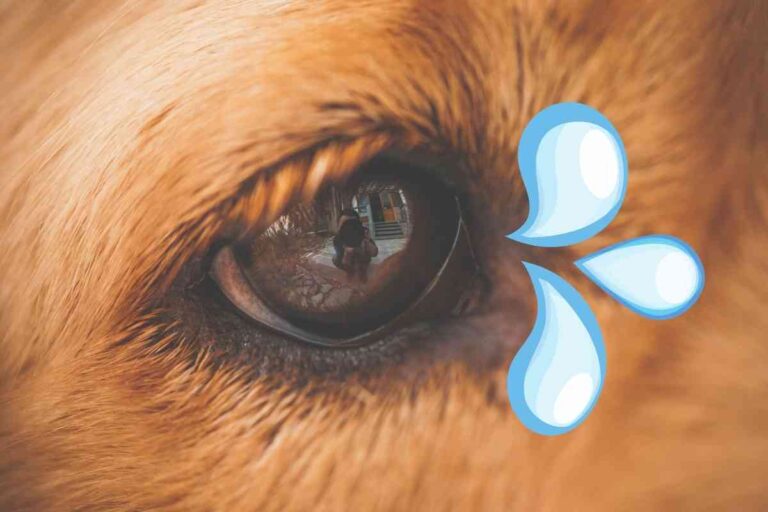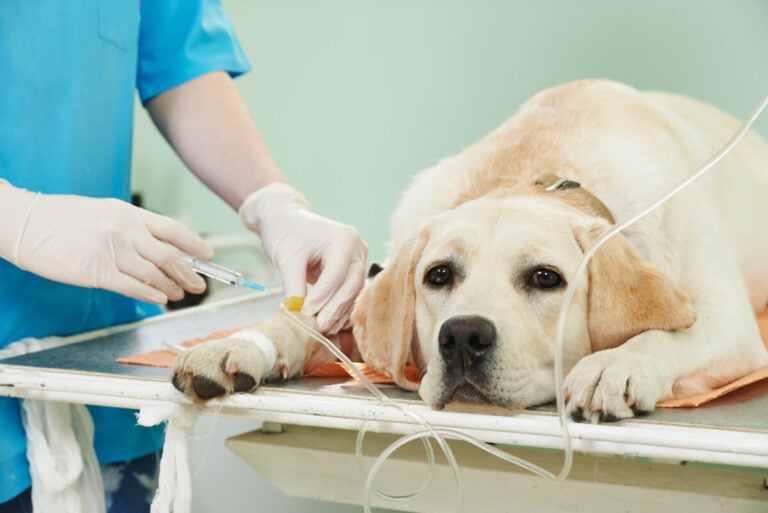Healthy Diet Plans for Labrador Retrievers: Expert Tips and Tricks
In the vast sea of articles and advice on the best diet for Labrador Retrievers, it’s easy to get swept away by the latest fads and anecdotal tales. Many sources offer guidance based on trends rather than tangible evidence.
However, this article takes a different route. Instead of following the crowd, we’ve delved deep into scientific studies specifically focused on Labradors.
Our aim? To provide you with a comprehensive guide on what science, not just popular opinion, says is the best diet for one of the world’s most beloved dog breeds.
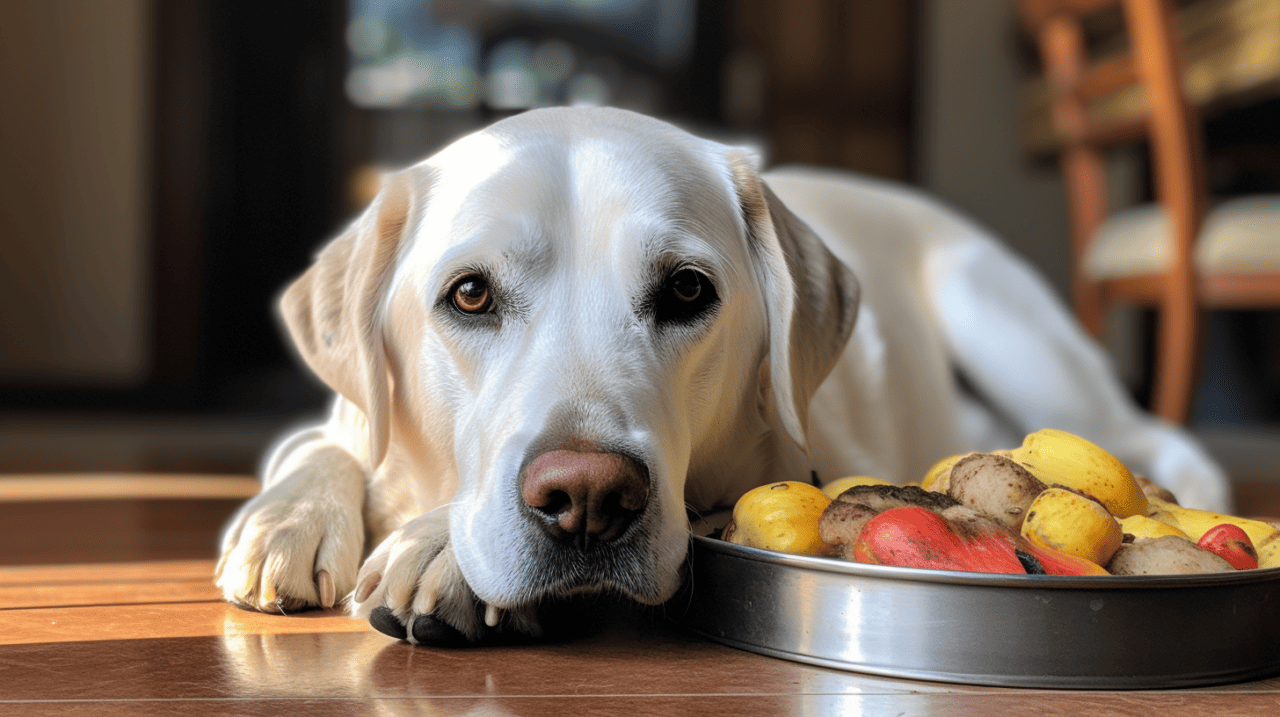
What’s the most healthy diet plans for Labrador Retrievers?
The best diet plan for Labrador Retrievers is grain, fiber, and nutrient-rich. Given their predisposition to weight gain, it’s essential to monitor calorie intake. A diet rich in high-quality proteins, whole grains, vegetables, and essential fatty acids is ideal. A diet based on grain, not legumes, avoids potential heart problems.
Read on to discover a diet for your Labrador that’s grounded in research and rooted in results.
Related Articles:
- Exercise Routines for Labrador Retrievers: Keeping Your Pup Healthy and Active
- Labrador Retrievers and Allergies: What You Need to Know

What the Science Tells us About Picking Healthy Diet Plans for Labrador Retrievers
Avoid Grain Free, High Legume Diets
When it comes to feeding our beloved Labradors, we all want the best for them. A recent study from the BMC Veterinary Research journal has shed light on the implications of grain-free diets for Labradors, and the findings are crucial for every Lab owner to understand.
Grain-Free & Legume-Rich: A Risky Combo? The study focused on Labradors fed a grain-free diet that was high in legumes like split peas and lentils. The results? Significant changes in blood parameters, similar to those seen in dogs with diet-induced dilated cardiomyopathy (DCM), a heart condition.
Taurine Levels Tell a Tale Taurine, a vital amino acid for heart health, showed fluctuating levels in Labradors on this diet. While there was an initial increase in taurine in the blood, by the end of the study, there was a concerning drop in urine taurine levels.
Connecting the Dots: Grain-Free Diet and DCM The study’s findings align with electronic health records of dogs diagnosed with DCM. This connection suggests that grain-free, legume-rich diets might be a contributing factor to the onset of this heart condition in dogs.
The Takeaway for Labrador Owners While the allure of grain-free diets might seem like a healthier option, this study suggests caution. Given the potential risks associated with such diets, it’s essential to prioritize your Labrador’s health and well-being.
Monitor Feeding to Avoid Obesity
Labrador Retrievers are known for their love of food, and many owners can attest to their Lab’s insatiable appetite. But have you ever wondered why some Labradors seem more food-driven than others? A study published in Cell Metabolism offers some intriguing insights that every Labrador owner should be aware of.
The Genetic Link to Food Obsession The research revealed a genetic modification in Labradors that heightens their interest in food. Specifically, a gene called POMC had a scrambled section of DNA in most obese Labradors.
This genetic alteration prevents the production of two substances that typically signal fullness after eating: the neuropeptides beta-MSH and beta-endorphin. As a result, these dogs might not feel as satisfied after a meal, leading to increased food-seeking behaviors.
Implications for Labrador Owners While not all Labradors with this genetic variation were obese, those with the deleted gene weighed, on average, 4.5 pounds more than their counterparts without the deletion. Owners also reported that these dogs displayed behaviors like frequent begging, increased attentiveness during meals, and scavenging for food scraps.
Interestingly, Labradors chosen for assistance roles were more likely to have this genetic variation. This suggests that their heightened interest in food might make them more responsive to food-based training rewards.
Avoiding Obesity: Why It Matters Obesity isn’t just about appearance; it’s a health concern. In developed countries, obesity affects 34-59% of dogs, leading to a shortened lifespan and various health issues similar to those seen in humans with obesity.
While environmental factors like reduced exercise and access to high-calorie foods play a role, genetic factors can also contribute, especially in breeds like the Labrador.

The Link Between Obesity and Lifespan in Labradors
A comprehensive study titled “Exceptional longevity and potential determinants of successful ageing in a cohort of 39 Labrador retrievers” sheds light on the profound impact of body composition on the lifespan of Labradors.
Key Insights:
- Lean Body Mass is Crucial: The research underscores the significance of maintaining lean body mass throughout a Labrador’s life. Labradors with leaner physiques exhibited slower increases in body fat percentage and retained their muscle mass longer than their counterparts.
- Body Fat and Lifespan: The study found a direct correlation between increased body fat accumulation and reduced lifespan. Labradors with minimal body fat lived longer, emphasizing the importance of keeping obesity at bay.
Furthermore, another study found additional benefits of a reduced calorie diet for labradors.
- Extended Lifespan with Caloric Restriction: Dogs that were fed a reduced-calorie diet lived a median of 1.8 years longer than those on an unrestricted diet. This significant extension in life is a testament to the importance of monitoring and controlling the caloric intake of our pets.
- Delay in Chronic Diseases: Not only did a calorie-restricted diet extend the life of the dogs, but it also delayed the onset of chronic diseases such as osteoarthritis. This means that not only do dogs live longer, but they also enjoy a better quality of life for a more extended period.
- The Obesity Connection: The unrestricted diet led to dogs being uniformly overweight, which directly correlated with a shorter median lifespan of 11.2 years. This emphasizes the detrimental effects of obesity on the overall health and lifespan of Labradors.
Takeaway for Labrador Owners
Avoiding obesity is paramount for Labradors. A balanced diet, regular exercise, and consistent monitoring of their body condition can not only extend their lifespan but also ensure a healthier, more active life. In essence, a leaner Labrador is likely to live a longer, more vibrant life.

How to Choose the Best Food for Labs
Choosing the Right Dog Food for Your Labrador: An Informed Guide
Labrador Retrievers, known for their friendly demeanor and boundless energy, deserve the best when it comes to nutrition. With a plethora of dog food options available, it’s crucial to make informed choices based on scientific research. Here’s a guide to help you navigate the world of dog food for your Labrador.
Grain is Good
- Whole Grains Over Grain-Free: Recent studies have shown potential health concerns with grain-free diets, especially those rich in legumes. Instead, whole grains like brown rice, wheat, and corn can be beneficial. They provide essential carbohydrates and are often recommended by the Association of American Feed Control Officials (AAFCO).
- Nutritional Balance: Grains offer a balance of nutrients, including vitamins, minerals, and omega-3 fatty acids, essential for a Labrador’s overall health.
Fillers Help Avoid Obesity
- Understanding Fillers: Ingredients often labeled as “fillers,” such as corn and wheat, can help Labradors feel full without consuming excess calories. This is crucial given Labradors’ propensity for weight gain.
- Quality Over Quantity: It’s essential to choose high-quality dog food brands, like Royal Canin and Purina, that use these ingredients responsibly. Look for those that adhere to AAFCO guidelines.
Base Protein on Activity
- Activity Levels Matter: The protein needs of a Labrador can vary based on their activity levels. Active working dogs, such as those involved in fieldwork, require more high-quality protein sources like chicken, beef, and lamb.
- Special Cases: Pregnant and nursing female Labradors have heightened protein and fat requirements to support their puppies’ growth and milk production.
- Choosing the Right Protein: While high-protein diets, often found in raw diets and raw feeding practices, can be beneficial for certain life stages or activity levels, they might not be ideal for all Labradors. It’s essential to balance protein with other nutrients, including carbohydrates from grains and vegetables like broccoli and carrots.

Feeding Labradors to Avoid Obesity: Practical Tips and Tricks
Labrador Retrievers, with their insatiable appetites and love for food, are often prone to weight gain. Obesity can lead to a myriad of health issues, from joint problems to heart conditions. Here’s how you can feed your Labrador to ensure they maintain a healthy weight:
1. Slow Feeder Bowls:
- Why Use Them? Labs often eat quickly, which can lead to overeating and digestive issues. Slow feeder bowls are designed with ridges and mazes to slow down the eating process.
- Benefits: These bowls promote better digestion, reduce the risk of bloating, and help your Labrador feel fuller with less food.
2. Food Toys and Puzzle Toys:
- Interactive Feeding: Toys like the Kong or treat-dispensing balls make your Labrador work for their food. This not only slows down their eating but also provides mental stimulation.
- Benefits: These toys can reduce boredom, which can sometimes lead to overeating. They also promote problem-solving skills and keep your Lab engaged.
3. Training Treats:
- Smart Rewarding: Instead of giving large treats, consider breaking them into smaller pieces or using specially designed low-calorie training treats. This way, you can reward your Labrador multiple times without adding too many extra calories.
- Benefits: Small treats can be used throughout the day for training sessions, reinforcing good behavior without the risk of weight gain.
4. Scheduled Feeding Times:
- Consistency is Key: Stick to a feeding schedule. This helps regulate your Labrador’s appetite and ensures they don’t overeat.
- Benefits: Regular feeding times can help in metabolism regulation and prevent overfeeding, which is a common cause of obesity.
5. Monitor Portion Sizes:
- Read the Label: Ensure you’re feeding the recommended amount based on your Labrador’s weight and activity level. Adjust as necessary if you notice weight gain.
- Benefits: Proper portion control is crucial in preventing obesity and ensuring your Labrador gets the right amount of nutrients.
6. Active Playtime:
- Exercise Matters: In addition to monitoring food intake, ensure your Labrador gets regular exercise. Play fetch, go for walks, or engage in agility training to keep them active.
- Benefits: Regular exercise helps burn off excess calories, strengthens muscles, and keeps your Labrador fit and healthy.
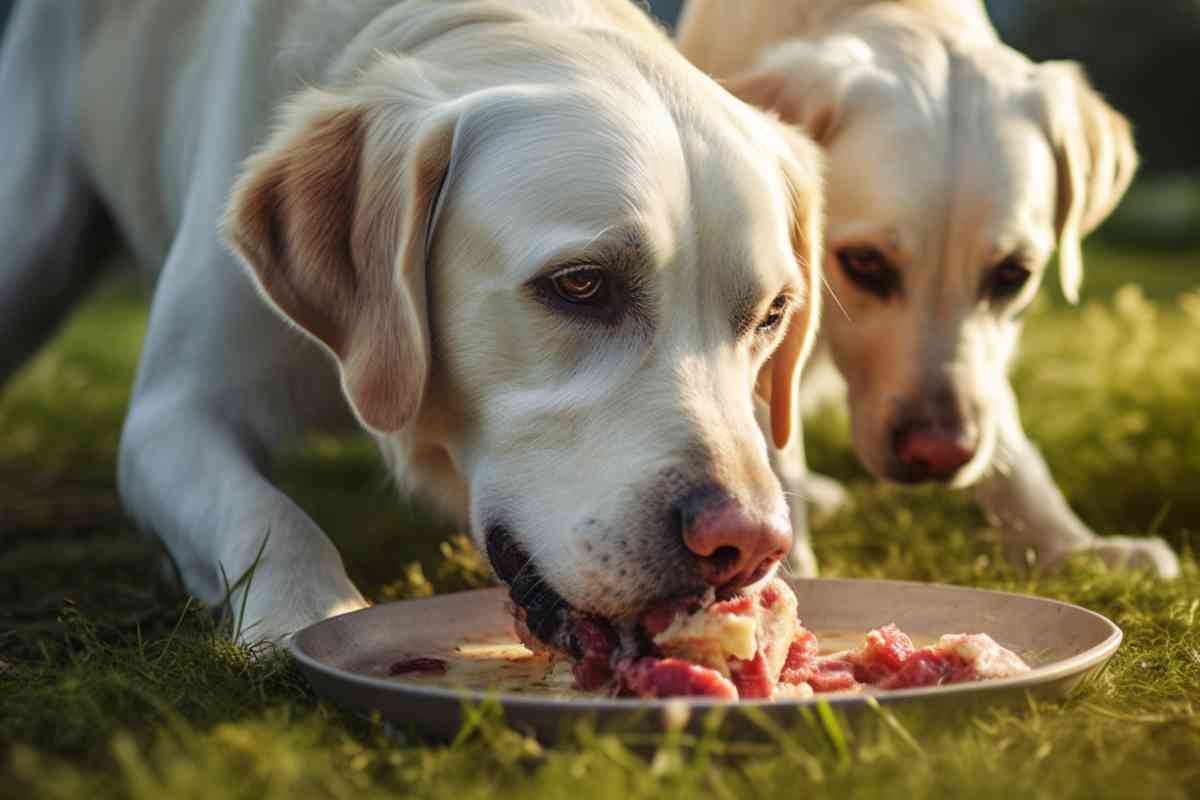
The Raw Food Debate for Labradors: Benefits, Risks, and Considerations
Labrador Retrievers, with their boundless energy and robust appetites, require a diet that supports their active lifestyles. One diet that has gained traction among dog owners is the raw food diet. But is it the right choice for your Labrador? Let’s delve into the raw food debate.
1. The Raw Food Appeal:
- Potential Benefits: Advocates of the raw food diet, often referred to as the BARF (Biologically Appropriate Raw Food) diet, argue that it’s more natural and can lead to shinier coats, healthier skin, higher energy levels, and smaller stools. Some also believe it may help avoid obesity, given its focus on high-quality protein and natural ingredients.
- Ingredients to Include: A raw diet typically consists of raw meat, bones, fruits, and vegetables. Ingredients like liver, kidneys, and other organ meats are often included for their nutrient density.
2. The Flip Side: Health Risks
- Bacterial Concerns: Raw diets can carry bacteria like Salmonella or E. coli, which can be harmful to both dogs and humans. Proper handling and storage are crucial to minimize these risks.
- Nutritional Imbalance: If not carefully planned, a raw diet can lead to nutritional deficiencies or excesses. For instance, a diet too high in liver can lead to an overdose of vitamin A.
3. The Importance of Fiber:
- Veggies and More: While raw diets emphasize protein, it’s essential to include a variety of vegetables like broccoli, carrots, and beans. These provide the necessary fiber to help Labradors feel full, aiding in digestion and promoting gut health.
- Benefits of Fiber: A diet rich in fiber can prevent overeating, which is especially beneficial for Labradors known for their insatiable appetites. It also ensures regular bowel movements and aids in nutrient absorption.
4. Making an Informed Decision:
- Consultation is Key: Before transitioning your Labrador to a raw diet, it’s essential to consult with a vet or a pet nutritionist. They can provide guidance on portion sizes, ingredient choices, and potential supplements to ensure a balanced diet.
- Safety First: If you choose to feed raw, ensure you’re sourcing high-quality ingredients, handling the food safely, and storing it properly to minimize health risks.
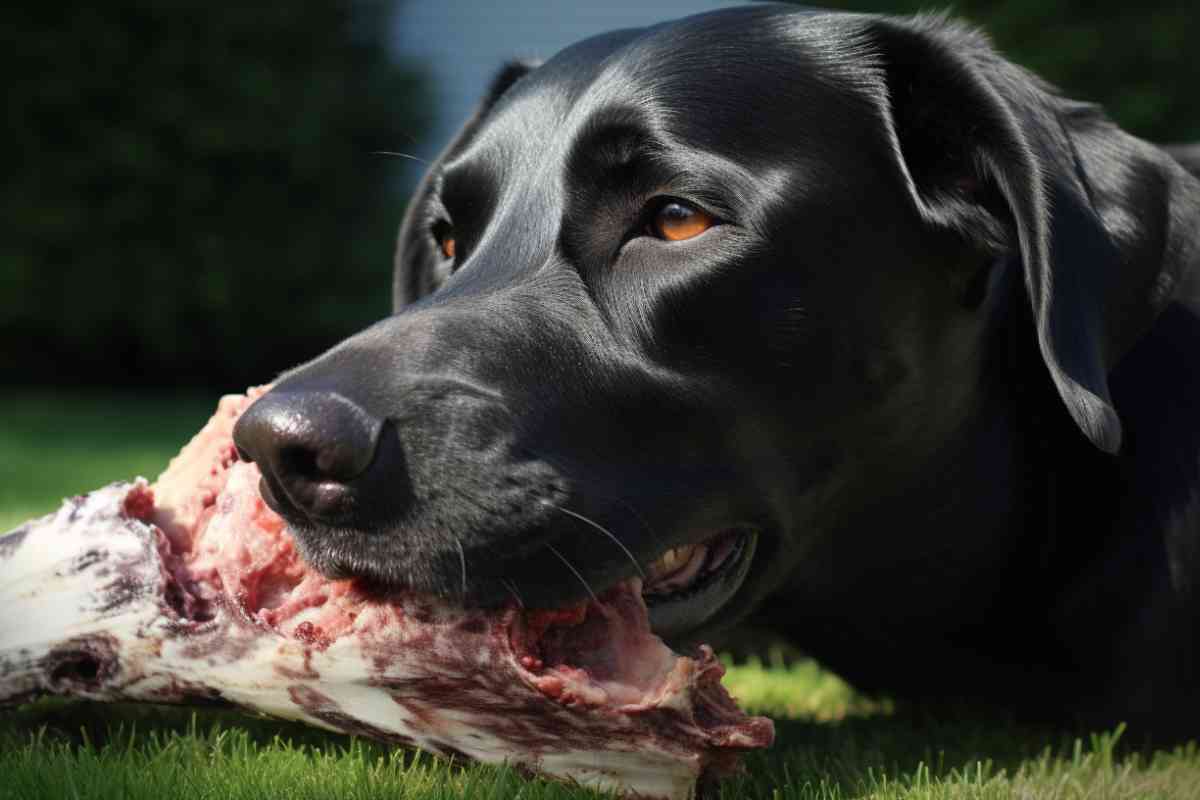
Choosing the Right Food for Labradors with Allergies
Labrador Retrievers, like many dog breeds, can be prone to allergies. Identifying and catering to these sensitivities is crucial for their well-being. Here’s a guide to help you navigate the world of dog food for your allergic Labrador.
1. Common Allergies in Labradors:
- Proteins: Some Labradors may be allergic to common protein sources like beef or chicken. Alternatives like turkey can be a good choice for such dogs.
- Grains: While grains are beneficial for many Labradors, some might show allergic reactions to ingredients like wheat or corn.
2. Types of Dog Food:
- Dry Food (Kibble): Kibble is a popular choice for many adult dogs due to its convenience and long shelf life. When choosing kibble for allergic Labradors, look for limited ingredient formulas that exclude common allergens.
- Wet Foods: Wet foods can be a good option for Labradors with allergies, especially if they are sensitive to certain preservatives commonly found in dry food. Always check the ingredient list to ensure it doesn’t contain allergens.
- BARF Diet: The Biologically Appropriate Raw Food (BARF) diet can be tailored to avoid specific allergens. However, if considering this route, ensure you’re providing a balanced diet and consulting with a vet.
3. Key Nutrients to Consider:
- Calcium and Phosphorus: These minerals are essential for bone health. Ensure that the dog food you choose, whether it’s for adult dogs or lab puppies, has an appropriate balance of these minerals.
- Avoiding Legumes: Recent studies have raised concerns about diets high in legumes for Labradors. While they can be a good protein source, it’s essential to ensure they aren’t the primary ingredient, especially in kibble.
- Watch the Fat Content: Allergic reactions can sometimes be exacerbated by high-fat diets. Ensure the food you choose isn’t too fattening, especially if your Labrador is prone to weight gain.
4. Tailoring for Life Stages:
- Lab Puppies: Labrador puppies have different nutritional needs than adult dogs. If your labrador puppy shows signs of allergies, ensure you’re choosing a puppy-specific formula that caters to these sensitivities.

Choosing the Best Diet for Labrador Puppies: A Comprehensive Guide
Labrador puppies, with their boundless energy and rapid growth, have specific dietary needs that differ from adult dogs. Ensuring they receive the right nutrients during this crucial growth phase can set the foundation for a healthy and active life. Here’s how to choose the best diet for your Labrador puppy:
1. Protein is Paramount:
- Why It’s Important: Protein supports muscle development and overall growth. Labrador puppies, being an active dog breed, require a higher protein content to support their rapid growth and energy levels.
- Sources to Consider: High-quality protein sources like chicken, beef, lamb, and turkey should be primary ingredients in the puppy food you choose.
2. Essential Fatty Acids:
- Brain and Vision Development: Omega-3 fatty acids, especially DHA, are crucial for brain and vision development in puppies.
- Sources: Look for puppy foods that include fish or fish oil as ingredients, as these are rich in essential fatty acids.
3. Balanced Calcium and Phosphorus:
- Bone Health: Labradors are a large breed, and their bones grow rapidly. A balanced ratio of calcium to phosphorus is essential to ensure proper bone development and prevent issues like hip dysplasia.
- Check the Label: Ensure the puppy food has an appropriate balance of these minerals, especially if you’re considering a raw or homemade diet.
4. Avoid Excess Calories:
- Risk of Obesity: Labradors are prone to weight gain. While puppies need more calories than adult dogs, it’s essential to ensure they’re not consuming excess calories, leading to early obesity.
- Portion Control: Feed measured amounts based on the puppy food’s guidelines and adjust based on your puppy’s activity level and growth.
5. Grains and Vegetables:
- Nutrient-Rich Carbohydrates: Whole grains like brown rice and vegetables like carrots and broccoli provide essential nutrients and fiber, aiding digestion and helping your puppy feel full.
- Allergy Considerations: Some puppies might be sensitive to certain grains. Monitor your puppy for any allergic reactions and consult with a vet if needed.
6. Avoid Fillers and Artificial Additives:
- Quality Over Quantity: Choose puppy foods that prioritize high-quality ingredients over fillers. Avoid foods with artificial colors, flavors, or preservatives.
7. Consultation is Key:
- Vet’s Advice: Always consult with a veterinarian or a pet nutritionist when choosing a diet for your Labrador puppy. They can provide guidance tailored to your puppy’s specific needs and growth stage.
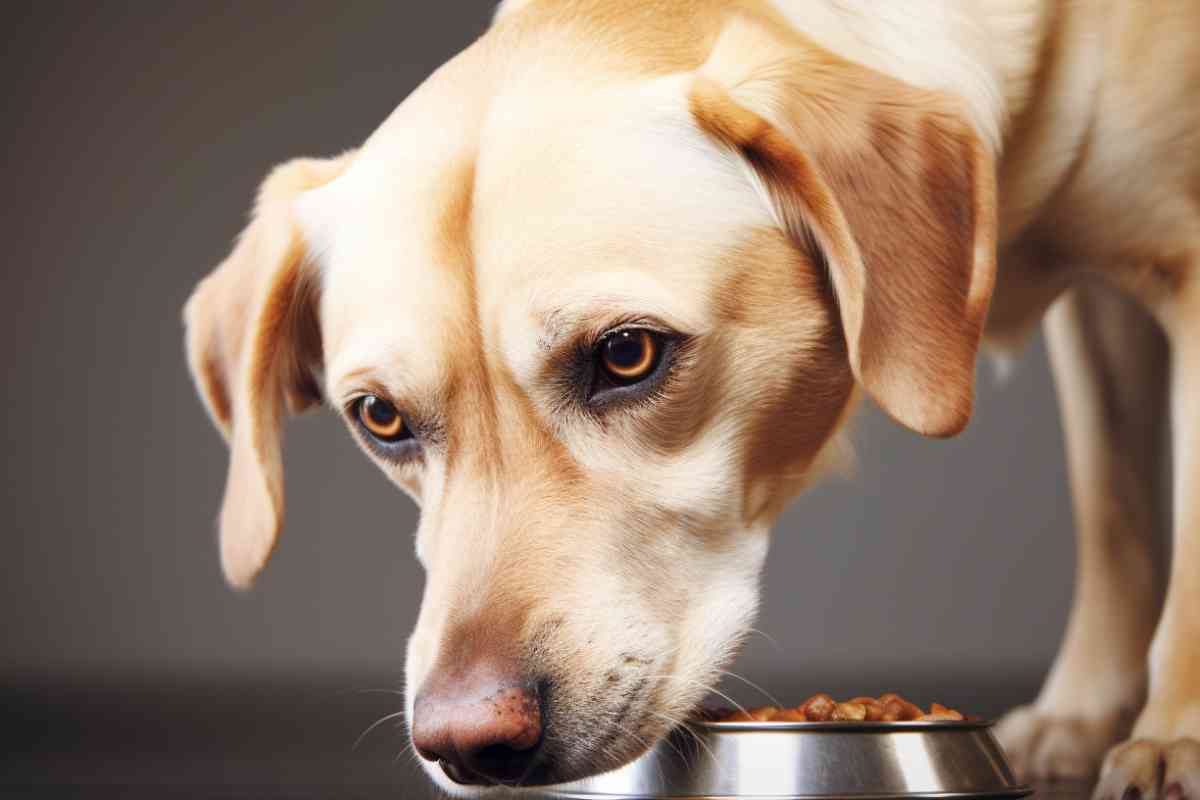
Feeding Labradors Leftovers: A Balanced Approach
Labrador Retrievers, with their ever-eager eyes and insatiable appetites, can make it hard for any dog owner to resist sharing a bite of their meal. While feeding your Lab leftovers can be a treat for them, it’s essential to do so with caution and knowledge.
1. Safe Foods First:
- Know What’s Safe: Not all human foods are safe for dogs. Before sharing any leftovers, ensure they don’t contain toxic ingredients like chocolate, grapes, onions, or xylitol.
- Opt for Veggies: Vegetables like carrots, green beans, and broccoli are not only safe for most dogs but also low in calories. Given Labradors’ propensity for weight gain, these can be excellent choices to share.
2. Beware of Fatty Foods:
- Weight Watch: Labradors are prone to obesity, so it’s crucial to avoid sharing fatty foods or large portions. Even a small amount of high-calorie food can contribute to weight gain over time.
- Lean Choices: If you’re keen on sharing meat leftovers, opt for lean cuts without sauces or seasonings. Grilled chicken or turkey can be a good choice, but always in moderation.
3. The Begging Behavior:
- Notorious Beggars: Labradors are known for their begging behaviors. Those pleading eyes can be hard to resist, but it’s essential to establish boundaries.
- Avoid Table Feeding: Feeding your Lab from the table can reinforce begging behavior. Instead, set aside a portion of safe leftovers and add them to their bowl during their regular feeding time.

Stick to Healthy Diet Plans for Labrador Retrievers
It’s undeniable—the pleading eyes of a Labrador can melt even the most resolute heart. Their innate ability to beg and look endearing can often lead us to make dietary concessions.
However, as tempting as it might be to give in, it’s essential to prioritize their long-term health and well-being. Numerous studies and research have shown that maintaining a healthy weight is crucial for Labradors, given their predisposition to weight-related issues.
Furthermore, despite the rising popularity of grain-free diets, a grain-rich diet has been proven beneficial for this breed. In the end, our love for our Labradors should manifest in the choices we make for their health.
By providing them with a balanced, grain-rich diet and monitoring their weight, we ensure that those beautiful begging eyes remain bright and healthy for years to come.




